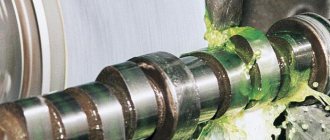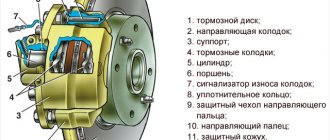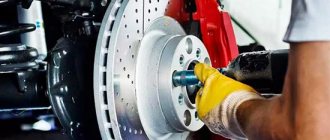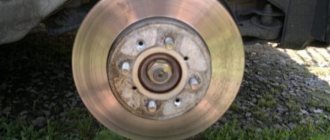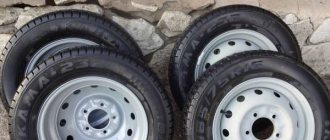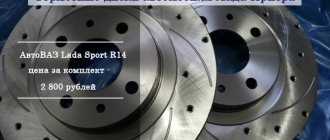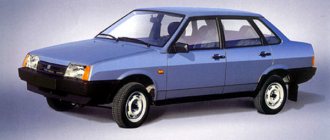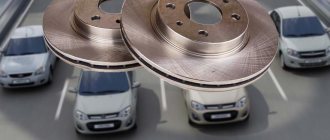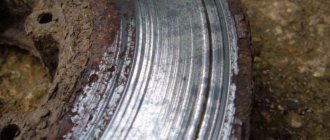Brake discs are one of the car components that require attention during maintenance. Failure to do so may require urgent and costly repairs. The brake disc stops the vehicle. Therefore, if there is a malfunction in this system, the car cannot be operated. It is important to carry out maintenance and, if necessary, repairs in a timely manner.
After a certain mileage, the brake discs are re-grooved. They are located on the car axle and are made of durable metal alloy. When braking, the pads put pressure on the disc on both sides. Thanks to the frictional force created at this moment, the machine stops. Over time, metal surfaces wear out and require maintenance.
When is brake disc resurfacing necessary?
It is not always possible to grind brake discs. This work should be entrusted to professionals. Otherwise, you may make a mistake and operating the vehicle will become unsafe. It makes no sense to perform grooving in the following cases:
- Presence of large cracks and chips. If the defects are in the base, a complete replacement of the system components is necessary. Otherwise, the metal may collapse soon, causing the wheel to jam. The brakes may fail with such a breakdown.
- Small thickness of discs. If the material is thin, it will heat up faster to the limit value at the moment of stopping. Some car models are initially equipped with a brake system that is not designed for grooving. Therefore, before performing such actions, you need to read the instructions.
If the chips or cracks are small and located closer to the outer edge, grooving can be done. If the thickness of the discs after processing is sufficient, repairs can be made. For models without ventilation, the outlet thickness is at least 8-9 mm. If there is ventilation, the permissible minimum thickness is 5-6 mm. Surface processing is performed on a lathe.
Why doesn't it make sense to sharpen brake discs?
Grooving car brake discs is a fairly common practice in Russia. But it’s better to do it as rarely as possible, as it will be a waste of money, and here’s why. General information. Brake rotors are consumable items similar to motor oils, filters and pads. They differ from them only in their longer service life. The average period is two changes of brake pads. Although the mileage level at which the discs become worn to a critical level rarely reaches 100 thousand kilometers. Most often, the limitation of their service life is from 60 to 80 thousand km.
In an ideal scenario, the braking discs on the car gradually become thinner until they reach the thickness set as the minimum. At the same time, the mirror surface for work remains smooth, without rust or sharp edges. But use without problems does not always happen. On some cars, the discs may warp, as a result of which the pedal may feel jerky when braking. In another case, the surface of the brake disc may wear unevenly, which is caused by a skewed caliper cylinder or souring of the guides. In both the first and second cases, the efficiency of the braking system will be reduced by an order of magnitude, and the car owner is faced with a choice - purchase new brake discs along with pads, or try to bring the old ones into working condition by trying to sharpen them.
To be honest, if the brake pedal and steering wheel start to wobble when braking, the brake discs should be replaced. To understand this, you need to understand the essence of the problem. Discs warp for a reason; for this to happen, they must be very overheated, or a huge temperature difference can be created. But even if such conditions are met, braking discs can rarely become crooked. In this case, it makes sense to pay attention to products sold by other manufacturing companies. After sharpening the disc, the problem will be eliminated, but this will not last long. If the drive is prone to overheating, it will fail again. In practice, it has been proven that this will happen after only a small mileage for the car.
The second reason why turning discs is a futile exercise is that the life cycle of such products is very short. Their manufacturers stipulate in advance the level of wear, exceeding which is undesirable. The most often acceptable value is no more than 1 mm on each side. If the thickness of the disk has decreased by as much as 2 mm, there is no point in sharpening it in the future; it is easier to send it to scrap metal.
The maximum degree of wear can be detected on the end part of the disk itself, or in the documentation for the car on which it is installed. In addition to the presence of wear, at the output at least 0.2 -0.4 mm will be removed from it, so that as a result, the customer can be given a part that is almost ready for disposal.
Bottom line. The reason for such a short period of use and recommendations from the manufacturer for frequent replacement is that for cast iron products, changes in ambient temperature are undesirable, which causes a change in the properties of the metal. Even slight wear of a couple of millimeters can cause the caliper or brake pads to become misaligned. Sometimes performing such a groove can cause an increase in the cost of the machine.
Recommendations after grooving
It is advisable to diagnose the brake system before carrying out the procedure. After grooving, it is advisable to avoid heavy loads on the car. You need to drive the first 50 km without sudden braking. The stop should be smooth. It is advisable not to drive on wet roads. If you have to drive in the rain, it is advisable not to get into deep puddles. You need to drive slowly on wet roads.
If you neglect these recommendations, the disc may become deformed. It may not be possible to restore the parts. The grooving work should be entrusted to qualified service station specialists.
When should it be done?
Every driver is obliged to monitor the condition of the brake discs. It is necessary to check elements for wear every 10-15 thousand kilometers using a caliper. But there is one subtlety in this issue. The fact is that during the operation of a car, brake discs tend to wear down unevenly. Over time, various deformations and grooves may appear on them, which significantly affect the quality of the vehicle braking process. Moreover, the service life of the brake discs may not be exhausted. In such a situation, grooving the elements may be the best option. You can recognize that there are problems with brake discs by the following signs:
- The braking process occurs unevenly and jerkily;
- The appearance of uncharacteristic sounds when braking;
- Beating of the brake pedal or steering wheel when braking;
- When you press the pedal, the brakes lock.
How does the disc grinding process work?
- The car is placed within the perimeter of the service station repair area and hung on a lift;
- Provide priority safety measures, squeeze the parking brake;
- Unscrew the bolts and remove the wheel;
- The shaft is fixed on the pin axis, the emery is applied, and the machine is started at minimum speed.
The rotation speed is increased as needed, depending on the size of the furrows. To prevent overheating, we recommend periodically watering the disc with running water.
The cycle of the operation is determined by the master, based on personal experience. The brake disc is not subject to further use if its actual thickness is less than 2/3 of the original thickness.
When to change
As a rule, brake discs last for two or three pad changes, but this is ideal. During intensive driving, the wear on the discs can become enormous and there will not be enough for the next pad replacement. Even if you drive in a quiet mode, brake discs are easy to “kill” .
For example, after heavy braking you find yourself in a puddle. Even a special shield under the wheel arch will not save you from water - it only protects from dirt. Because Since most brake discs are made of cast iron, they are subject to sudden temperature changes when water from a puddle cools them sharply. This leads to warping of the working surfaces, which will affect the steering wheel and brake pedal of the car. And it manifests itself when you begin to brake smoothly, and a slight tremor is felt on the steering wheel and brake pedal.
Cast iron is the most common material for brake discs. But with a sharp change in temperature, it changes its hardness, volume and internal structure. There are more durable analogs - ceramic, composite, which provide better stability and braking, but are more expensive.
Process without removal
Why did I start with it, because it is the easiest and more or less simple. So, I’ll describe it step by step:
- The car is suspended on lifts and the wheel is removed
- The caliper is unscrewed (hung by the holder to the spring), releasing the disc
- The approximate curvature of the canvas is measured. Needed to understand how much to sharpen
- Next, a special motor is installed on the studs or fastening points, which will spin the disk
- A special frame is screwed into the “ears” of the caliper, along which the cutters will run. AND immediately grinding down two planes from above and below.
- The grooving process begins, usually a little is removed, because there is a minimum permissible thickness
The big advantage of this method is that the disc is not removed from its mounting location, that is, the third plane (where it meets the hub) is not used. IT IS IMPORTANT! The new surface is filled only on two WORKING SIDES (where the pads go), all irregularities and excess are removed. The method itself is advanced, but it has an undeniable disadvantage, just like the other one (more on that below).
Is it worth grinding
If the brake disc of a car has wear in the form of irregularities on the surface, then they can be sharpened. The main thing is to determine the wear so that the thickness allows it to be sharpened. Too thin cannot be sharpened; they will not withstand heat load well, which will result in their destruction. Also, before grooving, they are checked for the degree of corrosion and the amount of runout. The cost of re-grooving is cheaper than the cost of new ones. If the residual depth allows them to be sharpened, then you can save on this operation. It is worth considering that it is necessary to sharpen both brake discs (so as not to shift the balance of the brakes) and then replace the pads with new ones. What is it for? If there was warping, then the friction layer of the pads was also damaged. If you do not change them, they will not fit the entire area. This will reduce the car's braking intensity.
Withdrawal process
Here, on the one hand, everything is much easier, on the other, much more difficult. It’s easier because the disc can be completely removed, there is no need to hang the caliper and attach any parts to the suspension itself. What’s more difficult is that you need to grind not just one surface, but three at once! Moreover, it is worth doing without removing the disk, it is fixed once, and we go through all the surfaces at once. If you shoot, the parallelism of the planes will definitely be broken, so you will make things even worse.
REMEMBER. In the method of grooving with removal, you need to process three surfaces at once WITHOUT REMOVING FROM THE MACHINE - the top, bottom and near the hub, so that they are all perfectly parallel! Otherwise there will be beating.
The whole difficulty here is that the cutter on the outside is easy to find, but it is DIFFICULT to climb back without removing it. A certain “device” will be required, such as a reverse cutter or a special machine.
What you can do with your own hands
Now on the Internet there are a lot of videos where “traditional craftsmen” make grooves with their own hands. Oh, as soon as they don’t do it - with a grinder, a file, etc. Some people even make a cut in the middle of the brake pad and insert a piece of sandpaper there.
Guys, it’s VERY DIFFICULT to do exactly with these methods, and even without getting hit! Although, as many say, it’s easy and simple! You may simply ruin discs that can still be sharpened on a machine. Also, if you shoot below the minimum thickness (and this is easy), then it is really dangerous.
Of course, I understand many villagers or residents of small towns, where there are NO normal services. But think for yourself, the brakes are your safety, and it doesn’t cost any money.
Now let's watch a short video version of the article.
I’ll end here, I think my materials were useful. Sincerely yours, AUTOBLOGGER.
( 14 votes, average: 4.93 out of 5)
Similar news
How and with what to paint the calipers. We select the optimal paint and color.
Why doesn't the handbrake hold (the parking brake doesn't work). Basic.
How to change brake pads. We disassemble the front axle + details.
Add a comment Cancel reply
Good day everyone, I decided to write my review of the 2010 Toyota Avensis. Just want…
TOP articles for the month
I have many different articles and videos on various gearboxes, for example here...
I already have an article on the website about choosing memory cards (you can see it here), it’s very...
In the article - is it possible to open windows when the air conditioner is running (you can read it here), I was asked...
Wear of the brake disc as a reason for its grooving
Wear on the working surface of the disk occurs for the following reasons:
- During the braking process, close contact occurs between the disc and the pads, and part of the working surface material is simply abraded mechanically.
- Dust, various particles of soil, road surface and other small contaminants get between the disc and pads, act as an abrasive, and increase the wear rate significantly.
- If worn down to the ground, brake pads, if not replaced in a timely manner, turn into a cutting tool and begin to remove disc material.
The wear process occurs uncontrollably and leads to uneven abrasion of the working surface. As a result, irregularities appear on it in the form of grooves, shoulders and waviness, which reduce braking efficiency even after replacing the pads with new ones.
Grooving the disc allows you to eliminate these defects and completely restore its functionality.
Recommendations for servicing the brake system
- Strictly observe the timing of inspections and preventive maintenance;
- Purchase original parts and their analogues according to the catalog numbers specified in the operating instructions;
- Avoid excessive wear of the friction lining and pads;
- Install new pads in pairs;
- Avoid getting into holes, bumps, potholes at medium and high speeds.
The cost of the disc pumping service is negotiated individually with the service station manager. A number of factors influence price formation:
- Degree of wear;
- Furrow depth;
- Presence of corrosion;
- Deformation, third-party mechanical damage.
In parallel with the restoration of the discs, inspect the friction linings, working cylinder, and pipes. If there are defects or cracks, replace the parts with new ones. It is unacceptable to use a technical device with a faulty brake system.
Once boring is complete, bleed the brake circuit. This is necessary to adjust the tightness of the pad to the disc body. Replace the fluid if sediment, cloudiness, or discoloration are visible. In cars produced after 2000, the brake circuit is filled with DOT-4 class fluid. The volume varies from 1.0 to 1.5 liters depending on the brand.
Special pads
Some car enthusiasts assemble a special device for grooving. It is made on the basis of old brake pads. Grooving is carried out using engine power and a hydraulic brake system. To do the job, you will need old pads, as well as a grinder with a diamond blade.
Procedure
- We buy a grinding disc. It is advisable to choose it with minimal abrasive, otherwise grooves may appear;
- A wedge is cut out of the SD; this shape allows the abrasive to be quite firmly fixed in the pad;
- Next, a wedge is cut into the brake pad itself for a piece of the grinding disc;
- Insert the resulting wedge into the block; the abrasive element should stick out a little. If this does not happen, then the block should be ground down a little;
- Next, the resulting grooving pads are installed in the calipers as usual;
- We make a groove, for this you need to drive 5-10 kilometers. While driving, periodically apply light pressure to the brakes. Avoid sudden braking. Such a trip is usually sufficient;
- The wheel is removed and the disc is inspected; usually this is sufficient. On some models, a bead may form. It can be removed using a regular file.
This method is quite simple to implement and can be used on both the front and rear wheels. Be sure to check the thickness of the disk in several places after the operation.
Several ways of grooving without removal
Whatever method of turning brake discs you choose, before you begin, make sure that their thickness is greater than the maximum permissible and that they are not cracked. If they are too thin or have cracks, don't risk repairing them. Better buy new ones. Grooving is the leveling of working surfaces using a cutter, and the methods proposed below are grinding brake discs without removal.
- There are special units for grinding brake discs without removal. But I think you will agree with me that it is not worth buying a unit just to grind a couple of discs. It will be cheaper to completely update the brake system.
- If the disks are on the drive axle. You will need a flat wooden block measuring 30x15x5 cm and several sheets of sandpaper with coarse abrasive grain (for example, No. 40) on a fabric base. Using sandpaper and a block is preferable to using an abrasive wheel for sanding. Because the working surface of the abrasive wheel will soon cease to be flat after the start of grinding. And the plane of the sides of the block will not change during operation. Don't forget to change the sandpaper - this will speed up the sanding process and improve its results. Raise the car with a jack and put some kind of insurance under it. Remove the wheel, brake caliper and brake disc boot. Hang the caliper higher so it doesn't interfere. Start the engine, put the gear in gear, and adjust the rotation to your liking. Lay a sheet of sandpaper with the abrasive down, place a block on it with the wide side, and bend the edges of the sheet protruding from under the block upward. Press the resulting structure alternately with its wide edge against the working surfaces of the brake disc. Do not try to press it harder, it is better to move the point of contact all the time.
- Brake mechanisms located on a non-driving axle are ground without removal using the same device made from a block and a sheet of coarse sandpaper. Only it will not be the disk that will move, but the block with sandpaper. It will be moved by the strength of your hands. But to tell the truth, doing this without removing the disk is very inconvenient; things will go much faster if you remove them and put them on the workbench.
- Grinding brake discs on the go. This method is suitable for restoring disks located on both the drive and driven axles. But it is suitable for eliminating only minor defects. It will not be able to eliminate the result of severe temperature deformation. First, special devices should be made from old brake pads. To do this you need a grinder with a diamond cutting disc. And also an abrasive cleaning disc for it. It is necessary to cut two wedge-shaped segments from the grinding wheel. Make two recesses in the old brake pads in accordance with the shape of the wedge fragments. Their depth should be a few tenths of a millimeter less than the thickness of the abrasive inserts, so that the latter, after installation, rise above the surface of the pads. Insert the sectors into the recesses, having previously lubricated them with some kind of glue so that they do not fall out. Install the resulting “abrasive pads” into the caliper instead of the standard ones. To sharpen working surfaces, you need to drive from 5 to 10 km, braking periodically. Plan your route to avoid sudden braking or slowing down on bumpy areas. During the trip, monitor the result of grinding. The bead formed around the perimeter of the disk can be removed after the end of the trip with an ordinary file with a large notch.
After leveling the working surfaces, it would not hurt to treat them with finer-grained sandpaper in order to reduce the depth of the marks. You should not immediately use fine-grain sandpaper, because it will make the surface less smooth and the surface will be smooth, but wavy.
Where to look for a fault
- The beating of the front discs is often reflected not only into the pedal, but also into the steering wheel.
- The rear beating is better felt through the vibrations on the body.
- The front mechanisms more often suffer from thermal deformation, since they bear the main load during braking, therefore, they heat up more. Deformation occurs as follows. When braking, the disc heats up and expands evenly. Water that gets onto a certain area quickly cools it, and as it cools, it shrinks and warps the entire part.
- The rear ones are more susceptible to corrosion. Since, due to their low load, water that gets on them does not dry out for a long time.
Using the NORDBERG NL1 stand
Using the Nordberg nl1 stand allows you to avoid even minor deviations in the work process, achieve ideal grooving accuracy and high quality grinding. This method is used to achieve a factory result.
The American stand is lightweight, compact, and mobile; thanks to the presence of various adapters, the machine can be used for various brands of cars. Any deviations are displayed on a high-precision device, which ensures excellent results. The spare part is untwisted using a special motor, the cutting unit is adjustable in height. The device is configured automatically; no additional mechanisms are required to carry out the procedure. To obtain an accurate result, it is necessary to place the cutters perpendicular to the axis.
